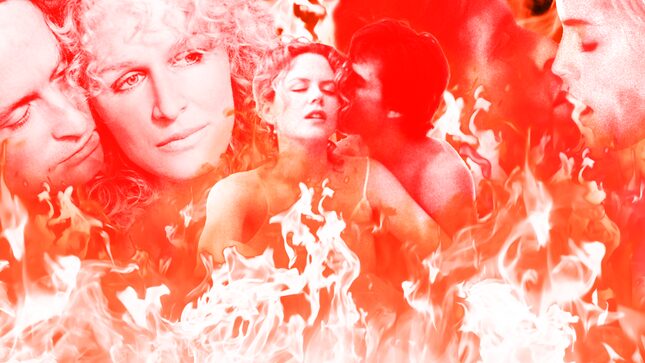The Lost Art of the Erotic Thriller
The erotic thriller rose to cinematic prominence with 1987's Fatal Attraction, and was dead in the water a decade later. What happened?
EntertainmentMovies
Graphic: Elena Scotti (Photos: Getty Images, Shutterstock)
Once upon a time, Tom Cruise and Nicole Kidman got stoned and discussed fidelity—the state of the union, if you will—for about 15 minutes straight, and for all the world to see. Not their union, but that of William and Alice, the characters they played in Stanley Kubrick’s swan song, Eyes Wide Shut. Against the golden glow of a bedroom lamp in the couple’s tony New York apartment, the scene unfurls like a ribbon of smoke in slow motion, keeping with the somnambulist pace of the movie whose dreamlike tone makes for an aerodynamic drag on its plot. He’s topless, she might as well be given the sheerness of her shirt, and they drift from affection to contempt, from pillow talk to real talk (or the approximation of it that such a stylized world allows). Nothing about their interaction suggests they have spent much time together, let alone that the stars had been married for more than eight years at the time of the film’s 1999 release.
Say what you will about its conservative core and the nonexistent chemistry of its then-married co-stars, Eyes Wide Shut nails the distinct flavor of confusion wrought by dreams. As the movie continues and Cruise’s doctor character drifts from one bizarre, innuendo-laden, and ultimately unsatisfying social interaction to the next, an unmistakable sense of what-the-fuck-was-that? mounts. Viewed today as an artifact, the film conveys a sort of meta-commentary on the subgenre whose conventions it played with and sometimes defied, the erotic thriller. This form that provocatively intertwined sex and violence and took up so much cultural space in the ’80s and early ’90s is now mostly dormant and seems itself like a thing of dreams looking back on it now. What the fuck was that?
The erotic thriller was to cinema history what Sharon Stone’s exposed vulva was to the genre’s vajazzled crown jewel, 1992’s Basic Instinct: A brief glimpse into the forbidden and a momentary flash so distracting as to remain indelible. In 1994, when film scholar Robert Barton Palmer published Hollywood’s Dark Cinema: The American Film Noir, he could convincingly argue that the erotic thriller was “perhaps the most popular genre in the 1990s.” But by the end of the decade, it was clear that flops had well outnumbered the smashes, and the genre had mostly migrated to the easily dismissed space of the small-budgeted direct-to-video market. By the new millennium, they were essentially gone, aside from the rare curiosity. “They don’t make ‘em like they used to” could be said about movies in general, given the continually evolving industry. “They don’t make ‘em, period,” is more like it regarding the erotic thriller.
The erotic thrillers of the ’80s and ’90s are now dated in the best way possible, relics of a very specific time and place. They are small history lessons that underscore the anxiety over dangerous sex, as well as the somewhat conflicting interests of consuming sex and punishment in a single sitting. Only in the late ’80s and ’90s—after the sex wars, against the backdrop of AIDS, and in the midst of increasingly fraught public discussions of gender politics—could pleasure and pain intertwine so enthrallingly on film.
Defining parameters would probably be useful here, though, in keeping with the twisty nature of their plots, the erotic thriller is difficult to pin down precisely. British film studies professor Linda Ruth Williams defined the genre like so: “Erotic thrillers are noirish stories of sexual intrigue incorporating some form of criminality or duplicity, often as the flimsy framework for onscreen softcore sex.” Bodily danger and pleasure must remain in close proximity and equally important to the plot.
Hallmarks of the genre include a femme fatale figure (the embodiment of dangerous sexuality), the testing and upholding of legality (via awry investigative procedure and courtroom drama), an adjective-noun naming convention (Fatal Attraction, Basic Instinct, Final Analysis, Mortal Passions, Wild Orchid), and gratuitous A-list full-frontal male nudity (Bruce Willis showed in The Color of Night, as did Kevin Bacon in Wild Things). Certain actors (Sharon Stone, Michael Douglas, Linda Fiorentino, Mickey Rourke), directors (Paul Verhoeven, Adrian Lyne), and writers (Joe Eszterhas) are associated with the genre. You’ll notice that many of those had a hand in the subgenre’s apotheosis, Basic Instinct.
it cannot be a mere coincidence that the deadliness of sex was being explored onscreen during a time when sex itself had been bestowed a newly deadly reputation in real life.
1987’s Fatal Attraction is generally credited with kicking off the erotic thriller craze proper, though the format had been germinating in mainstream cinema since the start of the decade via Brian de Palma’s Hitchcockian 1980 thriller Dressed to Kill and Lawrence Kasdan’s 1981 steamfest Body Heat. In her 2008 memoir Send Yourself Roses, Body Heat star Kathleen Turner argues that it was precisely because they were working in an old-Hollywood framework that they were able to get away with the sexual explicitness that would set the tone for the ensuing decade: “Film noir has a formality and shape to it. Its very familiar form allowed people to accept more readily the daring content that we were presenting.”
Williams writes that erotic thrillers “operate with a constant awareness of masturbation as a prime audience response and index of the film’s success,” and it only follows that they thrived on home video. A 1993 USA Today article called the erotic thriller “one of the fastest-growing genres in video stores,” reporting that these “dressed-up and sexed-up B-movies,” could be made cheaply and quickly. But while the direct-to-video market was an important part of the overall narrative of the erotic thriller, I’m much more interested in what Hollywood got away with in the light of day (which is to say, the glow of the multiplex’s silver screen).
-

-

-

-

-

-

-

-

-

-

-

-

-

-

-

-

-

-

-

-

-

-

-

-

-

-

-

-

-

-

-

-

-

-

-

-

-

-

-

-








































